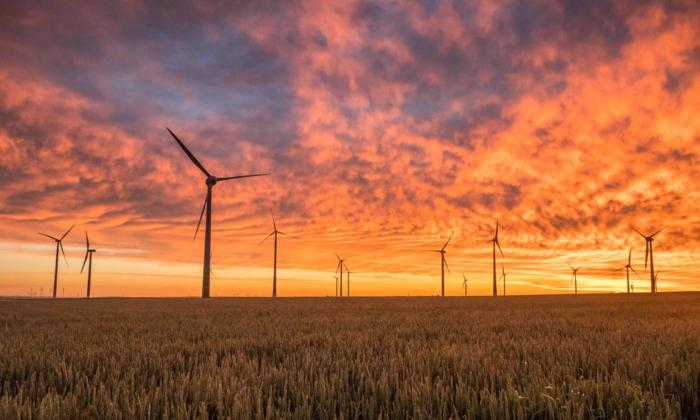The Biden administration is misleading the country about the amount of land that will be required to meet its ambitious renewable energy goals, RealClearInvestigations (RCI) has found.
The Department of Energy’s official line—echoed by many environmental activists and academics—is that the vast array of solar panels and wind turbines required to meet President Joe Biden’s goal of “100 percent clean electricity” by 2035 will require “less than one-half of 1 percent of the contiguous U.S. land area.” This topline number translates into 15,000 of the lower 48’s roughly 3 million square miles.
Even that figure is misleading because it does not include land for the new transmission systems that would connect the energy, created by the solar panels carpeting the ground and skyscraper-tall wind turbines filling the horizons, to American businesses and homes.
“It’s hundreds of thousands of acres if not millions for transmissions alone,” said David Blackmon, an energy consultant and writer based in Texas. “The wind and solar farms will take enormous swaths of land all over the country, and no one is talking about that.”
And these vast plots, along with the chains of transmission towers, do not include other aspects that would take up even more land: nationwide vehicle charging stations, mines for rare-earth minerals, maintenance space for huge propeller blades and panels, and so forth.
“We’ll have to build as much new clean generation by 2035 as the total electricity produced by all sources today, then build the same amount again by 2050,” Mr. Jenkins wrote. “This could ultimately require utility-scale solar projects that cover the size of Massachusetts, Rhode Island, and Connecticut combined, and wind farms that span an area equal to that of Illinois, Indiana, Ohio, Kentucky and Tennessee.”
Given the ambitious goals and tight time frames President Biden has committed the nation to, it seems natural to assume there would be a master plan detailing where and when this renewable infrastructure will be built and come online. Yet despite strong resistance by many communities across the country to serve as hosts for these massive projects, there has been no robust public debate about how all the necessary land will be acquired—and whether, for example, it will include the taking of private property through eminent domain or use of national park lands, an idea the government officially dismisses.
Experts skeptical about President Biden’s goals say the land requirements are so immense and problematic that such detail would likely reveal how unworkable the entire program is.
William Smith, a professor of Earth, Environmental, and Planetary Sciences at Washington University in St. Louis and a member of the CO2 Coalition, a group of scientists who do not believe global warming is an apocalyptic development, said, “Of course, it will never happen.”
The “less than one-half of 1 percent” figure is fantasy, according to Mr. Smith.
“A lot more area is required,” he said.
The United States currently uses an estimated 126,562 square miles for energy production, a bit more than the combined land mass of Missouri and Florida, with by far the biggest chunk devoted to growing corn for heavily subsidized ethanol fuel. In 2021, the last year for which figures are available, the United States got 2.8 percent of its energy from solar sources and 9.2 percent from some 72,000 wind turbines, according to government figures.
From Federal Agencies, the Rosiest Picture
There is little agreement, however, on how much electricity the United States will need in 2035 or 2050—and, hence, the number of solar installations and wind turbines—because that depends on a variety of lifestyle decisions, such as the type of cars people will drive and the size of the homes they will live in. In addition, the power generation of those turbines and solar panels depends on where they are situated—which is also unknown—and their age.These and other variables, in turn, can politicize an ostensibly scientific problem as the factors and assumptions one uses to ask key questions necessarily influence the answer.
Pushing the goal to a “NetZero” future in 2050, Bloomberg reported, would “need up to four additional South Dakotas to develop enough clean energy to run all the electric vehicles, factories and more.”
Spinning Turbines
Probably the greatest area of confusion surrounds the amount of land required by wind turbines. In support of its claim that the United States will need only 15,000 square miles of land to meet President Biden’s renewable goals by 2035, a Department of Energy spokesperson told RCI that the country will need an estimated 5,800 to 11,200 square miles for solar installations and between 1,930 and 3,100 square miles for wind turbines by 2035. But those numbers account for just the physical space required by each turbine—the stake in the ground, which is small—and not the broader area required by turbines, which must be spaced far apart from one other and require huge bases made from 2,500 tons of concrete.Those who support renewables claim that almost all of the surrounding land can still be used for farming, ranching, or other purposes. Even here, however, the numbers do not align. The Energy Department told RCI that “95 percent of the land” in wind farms remains untouched by the renewable energy apparatus, meaning the turbines would occupy but 5 percent of the land. But the National Renewable Energy Laboratory lowers that figure further, claiming that only 2 percent of the land is removed from circulation, and, in parentheses in his Mother Jones piece, Mr. Jenkins marks it down to 1 percent.
Those who believe the emissions goals set for 2035 and beyond are unrealistic and unnecessary say those numbers are absurdly low, and they characterize as false the notion that towering turbines—plus the construction needed to store and transmit energy that relies on fickle sources such as sunshine and wind—will not eat up many thousands of additional square miles.
When factors beyond sticks on the horizon are factored in—that is, the total parameters of wind farms—the plots needed get much bigger, as the National Renewable Energy Laboratory (134,000 square miles) and Mr. Jenkins (213,000 square miles) acknowledge in their studies.
Then, given that power weakens the farther it must travel to the end user, a gigantic new transmission system will be needed.
Here again, RCI found widely disparate estimates. In March, a DOE study stated that 47,000 new miles of high-voltage transmission wires would have to be constructed, but a National Renewable Energy Laboratory study looking at 2035 noted that the United States could need up to 100,000 miles of new lines during the next decade. The low end of that estimate is the distance of 10 round trips from New York to Moscow, while the high end is four times the earth’s circumference at the equator.
Again, the jumping numbers underscore how policymakers consistently highlight the lowest possible figures, which are derived using what could prove fanciful assumptions.
The renewable energy lab’s suggestion that turbines will take up only 2 percent of land is false, according to Mr. Smith.
“No matter how you slice it, the NREL estimate is utter rubbish, but is 100 percent accepted since it toes the narrative line,” he said. “It is comforting until it is proven to fall drastically short by sad experience. Ten percent of that land, at least, is useless for other purposes. No one wants to live under, near, or in the line throw from a wind turbine in northern latitudes.”
In addition, there is something disingenuous about pretending enormous windmills and high voltage transmission towers and wires are mere blips in the landscape, according to Mark Mills, a senior fellow at the free-market Manhattan Institute and a faculty fellow at Northwestern University’s McCormick School of Engineering and Applied Science.
“Like all scenarios, it depends on boundary condition assumptions,” Mr. Mills said. “NREL, for example, uses the specific footprint of the concrete pad on which the wind turbine physically sits, rather than the acres of land occupied by the array of turbines. That yields a very small number of course, despite the visual scale of the array.”
Mr. Mills acknowledged wind farms do not completely rule out farming or other land uses nearby, gaps that are not available with solar panels, which render whole square miles of land “useless for other purposes.”
These factors tend to be elided when enthusiasts predict that smaller and smaller allotments of land are required for the transformation envisioned.
“I don’t hear any of them talk about the land footprint at all,” said H. Sterling Burnett, director of Arthur B. Robinson Center on Climate and Environmental Policy at the Heartland Institute, a conservative think tank opposed to massive renewable energy projects. “The whole NIMBY mindset is not unique to fossil fuels. But if you’re talking about building turbines in Kansas and shipping power to New York City, or all the power lines that will be needed—nobody talks about that.”








